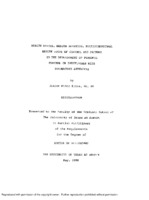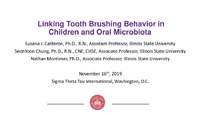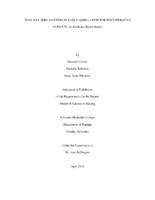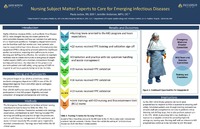| dc.contributor.author | Delnay, Nancy | en |
| dc.date.accessioned | 2018-01-05T16:06:28Z | |
| dc.date.available | 2018-01-05T16:06:28Z | |
| dc.date.issued | 2018-01-05 | |
| dc.identifier.uri | http://hdl.handle.net/10755/623729 | |
| dc.description.abstract | <p><strong>Introduction:</strong> Juvenile idiopathic arthritis (JIA) and periodontal disease (PD) are both diseases of inflammation identified by redness and swelling. Most periodontitis cases among children and adolescents occur as a manifestation of certain systemic disease with an impaired immune system that compromises their response to microbial plaque (Alrayyes S, 2011). In 2016, Lange et al. reported children with CCP positive JIA having higher antibody titers to <em>Porphyromonas gingivalis (Pg)</em> and more symptoms of poor oral health. <em>Pg</em> is one of an estimated 500-700 species of bacteria that exist in the oral cavity with fewer than 5% of them being causative for periodontal disease (Bik, 2010) (Dewhirst FE).</p>
<p><strong>Purpose:</strong> The purpose of this study was to determine the presence of the bacteria <em>porphyromonas gingivalis (Pg)</em> in children with JIA who are positive for either rheumatoid factor (RF) or CCP.</p>
<p>Results of this study will guide further research in the role of oral microbiota and JIA. Ultimately such knowledge may lead to early intervention and prevention of inflammatory conditions.</p>
<p><strong>Methods:</strong> A convenience sample of 12 children ages 10-21 with a diagnosis of JIA and either RF positive or CCP positive was selected from a hospital based rheumatology clinic. JIA disease activity is calculated as low, medium or high (Buekelman, 2011). PD is determined by oral exam. A saliva sample was collected to identify the presence of common pathogens associated with PD and increased risk of systemic disease. The bacteria were tested by PCR amplification followed by fluorescent endpoint detection of sample bacterial concentrations. Bacteria were reported as low, moderate or high risk for association with periodontal disease.</p>
<p><strong>Results:</strong> Half of the children had medium disease activity for JIA (50%); one with high disease activity and the remaining 5 (41%) with low activity. Upon physical examination 7 of 12 children (58%) examined showed signs of localized inflammation of gingiva to one or more teeth, none of the 12 had generalized gingiva inflammation. The patient with the highest level of pathogens had low level of JIA disease activity. All 12 children were positive for a moderate risk pathogen Fusobacterium nucleatum (Fn). Fn is a common bacteria and when compared with a gender age matched control group this result was not significant. The control group consisted of patients undergoing evaluation and treatment for PD. Only 2 of 12 children (17%) had presence of Pg: neither had bleeding with brushing or flossing and one exhibited localized gingiva redness.</p>
<p><strong>Discussion: </strong>Pg was not found to be prevalent in children with JIA who were positive RF or CCP. Presence of moderate and high risk bacteria existed in the children with JIA but was not significantly different than the control group children with PD. The study is limited by the small sample size and control group with PD. Future studies would include a control group from the general population or other children with JIA. The presence of bacteria associated with an inflammatory process such as PD emphasizes the importance of inclusion of oral health exam.</p> | en |
| dc.description.sponsorship | The DAISY Foundation | en |
| dc.description.sponsorship | Akron Children's Hospital | en |
| dc.description.sponsorship | Akron Children's Foundation | en |
| dc.format | Text-based Document | en |
| dc.subject | Juvenile Idiopathic Arthritis | en |
| dc.subject | Periodontal Disease | en |
| dc.subject | Oral Microbiota | en |
| dc.subject | Porphyromonas Gingivalis | en |
| dc.title | Mouth matters | en |
| dc.title.alternative | Pathogens in the inflammatory process of periodontal disease and juvenile idiopathic arthritis | en |
| dc.type | Poster | en |
| dc.rights.holder | <p>
All rights reserved by the author(s) and/or publisher(s) listed in this item record unless relinquished in whole or part by a rights notation or a Creative Commons License present in this item record.
</p><p>
All permission requests should be directed accordingly and not to the Sigma Repository.
</p><p>
All submitting authors or publishers have affirmed that when using material in their work where they do not own copyright, they have obtained permission of the copyright holder prior to submission and the rights holder has been acknowledged as necessary.
</p> | en |
| dc.type.category | Full-text | en |
| dc.evidence.level | Case-Control Study | en |
| dc.research.approach | Pilot/Exploratory Study | en |
| dc.subject.cinahl | Arthritis, Juvenile Rheumatoid | en |
| dc.subject.cinahl | Periodontal Diseases | en |
| dc.subject.cinahl | Arthritis, Juvenile Rheumatoid--Complications | en |
| dc.subject.cinahl | Microbiota | en |
| dc.contributor.department | Delta Omega | en |
| dc.author.details | Nancy Delnay, CNP, MSN, RN, Akron Children’s Hospital, Akron, Ohio | en |
| dc.conference.name | 10th annual Rheumatology Nurses Conference | en |
| dc.conference.host | Rheumatology Nurses Society | en |
| dc.conference.location | Orlando, Florida, USA | en |
| dc.date.conferenceyear | 2017 | |
| dc.description.reviewtype | Peer-review: Single Blind | en |
| dc.description.acquisition | Self-submission | en |





